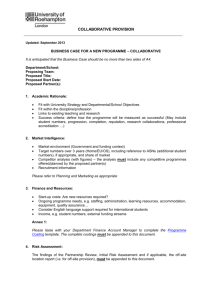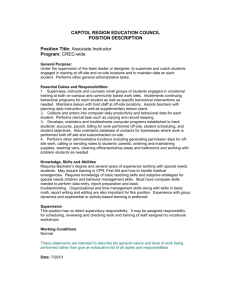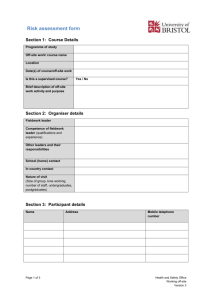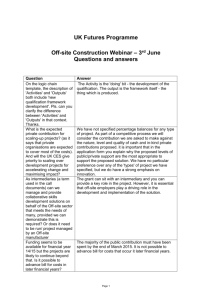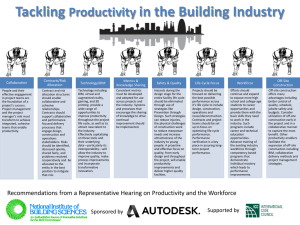Report of the Results of the 2015 Off-Site Construction Industry Off-Site Construction
advertisement
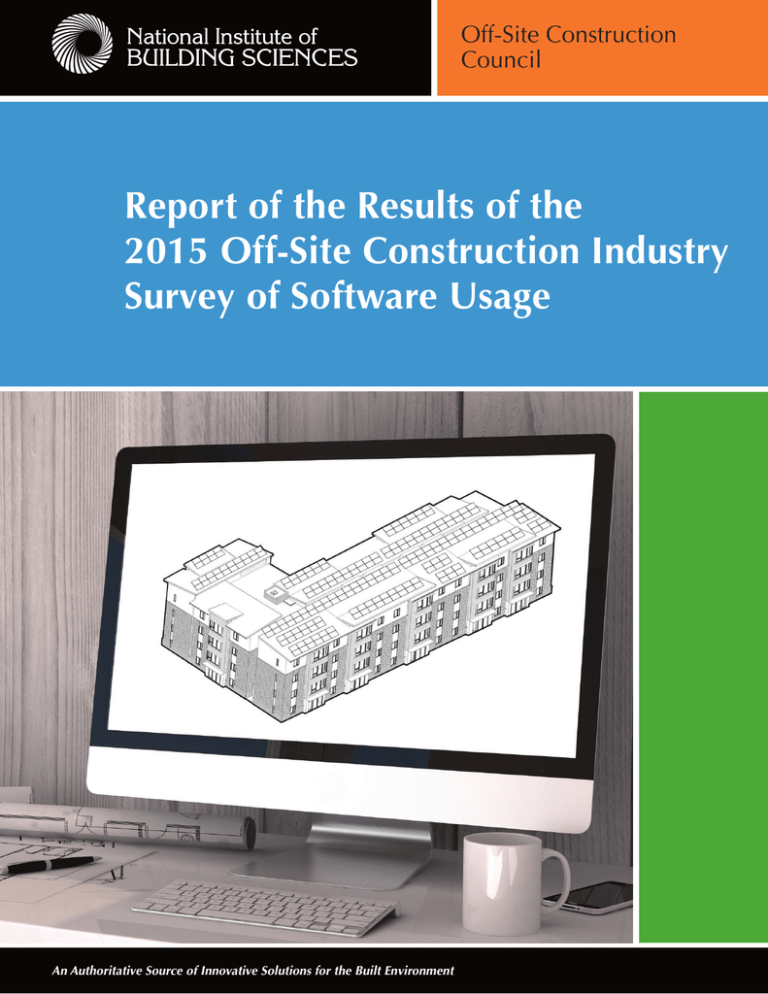
Off-Site Construction Council Report of the Results of the 2015 Off-Site Construction Industry Survey of Software Usage An Authoritative Source of Innovative Solutions for the Built Environment 2015 OFF-SITE CONSTRUCTION INDUSTRY SOFTWARE SURVEY RESULTS 1090 Vermont Avenue, NW, Suite 700 Washington, DC 20005-4950 (202) 289-7800 (202) 289-1092 fax www.nibs.org Off-Site Construction Council Research by: Ryan E. Smith, OSCC Past-Chair, Associate Professor, Director, University of Utah, Integrated Technology in Architecture Center Talbot Clark Rice, Associate Researcher, University of Utah, Integrated Technology in Architecture Center ii © National Institute of Building Sciences 2015 OFF-SITE CONSTRUCTION INDUSTRY SOFTWARE SURVEY RESULTS Report of the Results of the 2015 Off-Site Construction Industry Survey of Software Usage Introduction In 2015, the National Institute of Building Sciences Off-Site Construction Council decided to survey the U.S. construction industry to better understand the kinds of software that industry professionals are using for their off-site constructed projects. This document, the Report of Results of the 2015 Off-Site Construction Industry Survey of Software Usage, compiles the answers to that survey. The data will serve as a benchmark for the Council to use moving forward. Thanks to the Off-Site Construction Council for assembling this report and to Autodesk for funding it. The results provide another point of reference, along with the Council’s other surveys, to show where the industry is today and the progress that still needs to be made in the coming years. This data will be made available for use in the Off-Site Construction Implementation Guide and to help the industry better put off-site construction methods into practice. Henry L. Green, Hon. AIA President National Institute of Building Sciences Off-Site Construction Council iii 2015 OFF-SITE CONSTRUCTION INDUSTRY SOFTWARE SURVEY RESULTS iv © National Institute of Building Sciences 2015 OFF-SITE CONSTRUCTION INDUSTRY SOFTWARE SURVEY RESULTS Report of the Results of the 2015 Off-Site Construction Industry Survey of Software Usage With the looming shortage of skilled craft workers in the construction industry forecast to exceed 2 million by 2017, many U.S. contractors are beginning to see off-site construction as a way to remain competitive, even with a lower-skilled workforce.1 Off-site construction is the planning, design, fabrication and assembly of building elements at a location other than their final point of assembly on the construction site. Off-site delivery is characterized by an integrated planning and supply chain optimization strategy.2 From heating, ventilation and air-conditioning (HVAC) duct fabrication to full volumetric modules delivered to a site and assembled, off-site prefabrication in the construction sector is growing and impacting projects at an increasing rate. The use of software is a primary means to communicate how these prefabricated elements are designed, manufactured and installed. In the summer of 2015, the National Institute of Building Sciences Off-Site Construction Council (OSCC) decided to conduct a survey to identify what kind of software platforms are being used in the off-site construction sector and their effectiveness in the industry. This is the third survey the OSCC has conducted. The previous OSCC surveys3 and other related research by industry partners4 have identified one particularly notable finding: When project stakeholders engage in project delivery earlier in the process, they increase communication and transparency, thereby making the project more successful, particularly as it relates to the project outcomes of cost, schedule, safety and quality. A key component to this communication is file sharing and software integration. To achieve these benefits, it is especially important for project teams to establish digital standards and communication early in the process to best achieve success in delivering off-site construction effectively. The National Institute of Building Sciences distributed the Off-Site Construction Industry Software Survey through its communications network, as well as to partnering organizations.5 While Autodesk provided the OSCC with funding to conduct the survey, respondents were not informed of such sponsorship. Further, Autodesk did not contribute to the content of the questions or suggest respondents. 1 “Permanent Modular Construction: Process, Practice, Performance.” Foundation Offsite PMC Report. Modular Building Institute. http://www.modular.org/HtmlPage.aspx?name=foundation_offsite_PMC_report 2 Glossary of Off-Site Construction Terms. National Institute of Building Sciences Off-Site Construction Council. http://www.nibs.org/resource/resmgr/OSCC/GlossaryOffSiteConstructionT.pdf 3 “Report of the Results of the 2014 Off-Site Construction Industry Survey,” Off-Site Construction Council, National Institute of Building Sciences. https://www.nibs.org/resource/resmgr/OSCC/NIBS_OSCC_2014Survey.pdf. 4 “Permanent Modular Construction: Process, Practice, Performance.” Foundation Offsite PMC Report. Modular Building Institute. http://www.modular.org/HtmlPage.aspx?name=foundation_offsite_PMC_report 5 Respondents were solicited through two news releases, the July 2015 e-newsletter and emails to Off-Site Construction Council and buildingSMART alliance members. Requests were sent to the Modular Building Institute; American Institute of Architects; Associated General Contractors of America and BIM Forum. In addition, informational postcards were distributed to participants at the Off-Site Construction Expo, held September 23-24 in Washington, D.C. Off-Site Construction Council 1 2015 OFF-SITE CONSTRUCTION INDUSTRY SOFTWARE SURVEY RESULTS A total of 22 participants completed the survey. Their answers, which were anonymous, are shown in the aggregate only. Though the response rate was not as high as expected, the results of this survey still identify some important data, such as the use and effectiveness of particular software platforms during the design, procurement and construction phases of delivery. More than 50 percent of the survey respondents identified the services their companies offer as either architecture/engineering or general contractor/construction managers (Question 5). Multiple respondents were located in Texas, California, Illinois and Ohio (Question 6). The survey participants all have used off-site construction elements in one or more of their projects in the past 12 months (Question 1). Participants were able to choose more than one option. Here are the types of uses, in order of most to least. • HVAC, Plumbing and Electrical Racks, Risers and Other Assemblies (Multi-Trade) (66.67%) • Structural Steel Assemblies (61.9%) • Precast Concrete Structure (61.9%) • HVAC, Plumbing and Electrical Racks, Risers and Other Assemblies (Single Trade) (52.38%) • Curtain Wall Assemblies (47.62%) • Prefabricated Exterior Wall Assemblies (38.1%) • Service Pods (Bathrooms, Utility Rooms, Etc.) (33.33%) • Equipment Skids (33.33%) • Prefabricated Interior Wall or Soffit Panels (33.33%) • Permanent Building Modules (i.e. Volumetric Construction) (28.57%) • Headwall Assemblies (23.81%) • Cross Laminated Timber Structure (14.29%) In the past 12 months, survey respondents indicated they have used Autodesk Revit more than any other software application during the pre-design, design, procurement, fabrication and construction phases. During the facilities management phase, respondents used five software applications in equal measure: Bluebeam Revu, Microsoft Project, Autodesk Navisworks, GoogleDrive and Box. (Question 2) When it comes to effectiveness, respondents ranked the Autodesk Revit software platform as the most effective or moderately effective software platform (Question 4). Though the survey lacked the number of responses to make it statistically significant, it still provides meaningful insight into the types of software the industry is utilizing for off-site construction projects. In 2015, the University of Utah’s Integrated Technology in Architecture Center (ITAC) conducted a study on permanent modular construction performance.6 In that survey, manufacturers indicated they primarily use Autodesk AutoCAD for their in-house needs (See Figure 1). This disconnect between what the architecture, engineering and construction (AEC) professionals and modular manufacturers are utilizing for software may point to a need to improve how digital communication is occurring between the design phase and fabrication phase in the off-site delivery process. This finding could suggest that additional functionality is required to bridge the gap between design and fabrication via software. In addition, the off-site construction sector and its stakeholders might benefit from standards for digital modeling and information sharing. This could take the form of indus- 2 © National Institute of Building Sciences 2015 OFF-SITE CONSTRUCTION INDUSTRY SOFTWARE SURVEY RESULTS try foundation class (IFC)-compliant files or Levels of Development (LOD) standards.7 There are very few software platforms that can take design information (solids modeling and associated data) and convert it to manufacturing data. These findings also could indicate that manufacturers are not utilizing the latest in building information modeling software (BIM) for their operations, preferring to use two-dimensional (2D) computer-aided design programs to generate shop drawings. If that is the case, the off-site construction industry may need additional education to connect the designers and builders with manufacturers to realize the greatest level of efficiency. The results of this survey and prior studies conducted by the OSCC will help form the content for an Off-Site Construction Implementation Guide. The OSCC is seeking additional support from companies and organizations in the building industry to assist in the research; collection of resources and potential case studies; and development of the implementation guide. The guide is intended to be a no-cost resource, broadly available to the construction sector. For more information about the guide or to support its development, please contact Ryan Colker at rcolker@nibs.org. To learn more about the Off-Site Construction Council, including how to get involved, visit www.nibs.org/oscc. Figure 1. Manufacturers’ Software Use Results from the recent ITAC and MBI study, “Permanent Modular Construction: Process, Practice, Performance” “Permanent Modular Construction: Process, Practice, Performance.” Foundation Offsite PMC Report. Modular Building Institute. http://www.modular.org/HtmlPage.aspx?name=foundation_offsite_PMC_report 6 See the National Institute of Building Sciences buildingSMART alliance, http://www.nibs.org/bsa and http://www.wbdg.org/bim/bim.php 7 Off-Site Construction Council 3 2015 OFF-SITE CONSTRUCTION INDUSTRY SOFTWARE SURVEY RESULTS 4 © National Institute of Building Sciences 2015 OFF-SITE CONSTRUCTION INDUSTRY SOFTWARE SURVEY RESULTS QUESTION 1 In the past 12 months, which of the following off-site elements have you incorporated into one or more of your projects? (Check all that apply.) Off-Site Construction Council 5 2015 OFF-SITE CONSTRUCTION INDUSTRY SOFTWARE SURVEY RESULTS QUESTION 2 In the past 12 months, what software applications have you used on offsite construction project(s), for the following project delivery phases?* * Respondents to the question were provided a link to a comprehensive list of software programs for reference. That list is available in Appendix A 6 © National Institute of Building Sciences 2015 OFF-SITE CONSTRUCTION INDUSTRY SOFTWARE SURVEY RESULTS Off-Site Construction Council 7 2015 OFF-SITE CONSTRUCTION INDUSTRY SOFTWARE SURVEY RESULTS 8 © National Institute of Building Sciences 2015 OFF-SITE CONSTRUCTION INDUSTRY SOFTWARE SURVEY RESULTS QUESTION 3 How often have you used the previously named software application(s) for off-site construction projects? Off-Site Construction Council 9 2015 OFF-SITE CONSTRUCTION INDUSTRY SOFTWARE SURVEY RESULTS 10 © National Institute of Building Sciences 2015 OFF-SITE CONSTRUCTION INDUSTRY SOFTWARE SURVEY RESULTS QUESTION 4 How effective are the software application(s) that you are using for implementing off-site construction projects? Off-Site Construction Council 11 2015 OFF-SITE CONSTRUCTION INDUSTRY SOFTWARE SURVEY RESULTS 12 © National Institute of Building Sciences 2015 OFF-SITE CONSTRUCTION INDUSTRY SOFTWARE SURVEY RESULTS QUESTION 5 What are the primary services your company offers? (Check all that apply) Off-Site Construction Council 13 2015 OFF-SITE CONSTRUCTION INDUSTRY SOFTWARE SURVEY RESULTS QUESTION 6 In what state is your company office located? 14 © National Institute of Building Sciences 2015 OFF-SITE CONSTRUCTION INDUSTRY SOFTWARE SURVEY RESULTS APPENDIX A Reference List of Software Products AUTODESK Autodesk 3D Studio or 3D Max Autodesk AutoCAD Autodesk Buzzsaw Autodesk Constructware Autodesk Ecotect Analysis Autodesk Fabrication for CAD MEP Autodesk Inventor Autodesk Navisworks Autodesk QTO Autodesk Revit Architecture Autodesk Revit MEP Autodesk Revit Structure BENTLEY Bentley AECOsim Bentley GEOPAK Bentley Hevacomp Bentley LEAP Bentley Limcon Bentley MicroStation Bentley ProjectWise Navigator Bentley ProStructures Bentley RAM Bentley Sectionwizard Bentley STAAD.Pro Bentley Tas BLUEBEAM BlueBeam Revu BlueBeam Vu BOX Box CADPIPE CADPIPE Commercial Piping CADPIPE Electrical CADPIPE Mechanical CADWORK CADWork DASSAULT SYSTEMES Dassault Systèmes CATiA Dassault Systèmes ENOVIA Dassault Systemes SolidWorks DATA DESIGN SYSTEM DDS-CAD DEPARTMENT OF ENERGY (U.S.) DOE EnergyPlus DOE2 eQUEST DIETRICH’S NA Dietrich’s Architecture Suite Dietrich’s Engineering Suite Dietrich’s Log Building Suite Dietrich’s Pre-Fab Design Suite Dietrich’s SIP Design Suite Dietrich’s Timber Framing Suite DROPBOX Dropbox FIRECAD FireCAD FLOWSIM FlowSim FloEFD FlowSim FloVENT GOOGLE Google Drive Off-Site Construction Council 15 2015 OFF-SITE CONSTRUCTION INDUSTRY SOFTWARE SURVEY RESULTS GRAPHISOFT Graphisoft ArchiCAD Graphisoft BIMcloud Graphisoft BIMx Graphisoft MEP Modeler HSBCAD hsbCAD HYDRATEC Hydratec HydraCAD Hydratec HydraCALC IES IES ApacheHVAC INNOVA SOFTWARE Innovaya Visual 4D Simulation M.E.P.CAD M.E.P.CAD AlarmCAD M.E.P.CAD AutoSPRINK MICROSOFT Microsoft CodePlex DB Profiler Microsoft Office Microsoft Project Professional Microsoft Sharepoint Microsoft Visio NEMETSCHEK VECTORWORKS Nemetschek Vectorworks Architect Nemetschek Vectorworks Designer Nemetschek Vectorworks Landmark NEWFORMA Newforma Project Center ODEON Odeon Room Acoustics Software RISA RISA 3-D RISAFloor RISAFoundation ROBERT MCNEEL & ASSOCIATES Robert McNeel & Associates nXt Robert McNeel & Associates Rhinoceros SEFAIRA Sefaira Architecture Sefaira Systems SERIF AFFINITY Serif Affinity Designer SOLIBRI Solibri Model Checker STRUCSOFT SOLUTIONS Strucsoft Solutions CMS Strucsoft Solutions MWF SYNCHRO SOFTWARE Synchro PRO Synchro Workgroup Project TEKLA Tekla BIMsight Tekla Fastrak Tekla Structures TRIMBLE Trimble Connect Trimble Design Link Trimble DuctDesigner 3D Trimble Field Points Trimble PipeDesigner 3D Trimble SketchUp Pro TRNSYS TRNSYS Energy Modeler VICO Vico Doc Set Manager Vico Office Suite Vico Takeoff Manager 16 © National Institute of Building Sciences 2015 OFF-SITE CONSTRUCTION INDUSTRY SOFTWARE SURVEY RESULTS About the Off-Site Construction Council: The U.S. off-site design and construction industry has made significant advances in implementing processes and materials to build and deliver more sophisticated and complex facility types by virtue of system prefabrication, unitization, modularization and panelization. More and more owners are turning to off-site methods for multi-story wood construction, steel framed structures, healthcare facilities, educational structures and large-scale military projects. As an industry, however, owners, architects, engineers and contractors up until now have lacked an unbiased source for evaluating the applicability and potential benefits for use of such methods; for determining where and when fabrication is appropriate; and for identifying the range of choices inherent in integrating and collaborating with fabricators. In 2013, the National Institute of Building Sciences established the Off-Site Construction Council (OSCC) to serve as a research, education and outreach center for relevant and current information on off-site design and construction for commercial, institutional and multifamily facilities. OSCC Board of Directors Sue Klawans, Chair Gilbane Building Co. Tom Hardiman, Vice-Chair Modular Building Institute Laurie Robert, Secretary NRB Ian Peter Atkins Gensler Jacinda Collins American Institute of Steel Construction Dean Frank Precast/Pre-stressed Concrete Institute Brad Guy Catholic University of America George Lea U.S. Army Corps of Engineers Dan Nyce Oldcastle Enclosure Solutions Allen Post Perkins & Will RJ Reed Whiting Turner Stacy Scopano Autodesk Ryan Smith, Immediate Past Chair University of Utah Jay Sztuk U.S. Department of Veterans Affairs Ryan Colker, Staff Director National Institute of Building Sciences About the Institute: The National Institute of Building Sciences is a non-profit, non-governmental organization that successfully brings together representatives of government, the professions, industry, labor and consumer interests, and regulatory agencies to focus on the identification and resolution of problems and potential problems that hamper the construction of safe, affordable structures for housing, commerce and industry throughout the United States. Authorized by the U.S. Congress, the Institute provides an authoritative source and a unique opportunity for free and candid discussion among private and public sectors within the built environment. The Institute’s mission to serve the public interest is accomplished by supporting advances in building sciences and technologies for the purpose of improving the performance of our nation’s buildings while reducing waste and conserving energy and resources. Off-Site Construction Council 17 National Institute of BUILDING SCIENCES Off-Site Construction Council 1090 Vermont Avenue, NW, Suite 700 Washington, D.C. 20005-4950 202-289-7800 www.nibs.org
